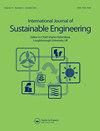空间分析,以量化和定位作为建筑材料潜在生物增强材料的残留豆蔻茎纤维
IF 3.6
Q3 GREEN & SUSTAINABLE SCIENCE & TECHNOLOGY
International Journal of Sustainable Engineering
Pub Date : 2022-02-21
DOI:10.1080/19397038.2022.2042620
引用次数: 2
摘要
今天,在欧洲,建筑部门负责50%的空气污染和70%的废物生产。因此,研究人员的兴趣集中在可持续、低影响、可再生和可回收的新型生态建筑材料上。在这种情况下,在过去几年中,使用纤维素基纤维作为生物复合材料的潜在增强材料,而不是合成纤维,受到了全世界越来越多的关注。在天然纤维中,无论是纤维素纤维还是蛋白质纤维,文献中发现,由于其机械性能,洋蓟纤维适合于这种用途。本文提出了基于地理信息系统(GIS)的Cynara cardunculus L. (CW)年农业废弃物量定位与量化模型,并在意大利南部研究区进行了应用。作为一种额外的蛋白质基纤维,由于绵羊的大量存在,羊毛纤维也被考虑在内。在地理信息系统地图上报告了这两种纤维的估计可用数量,以便显示它们在领土一级的分布情况。所取得的结果可以为可持续定位收集中心和分析与物流和供应阶段有关的环境影响提供基本信息。本文章由计算机程序翻译,如有差异,请以英文原文为准。
Spatial analysis to quantify and localise the residual cardoon stem fibres as potential bio-reinforcements for building materials
ABSTRACT Today in Europe building-sector is responsible for the 50% of air pollution and for 70% of waste production. For this reason, researchers’ interest is focused on new eco-building materials that are sustainable, with low impact, renewable and recyclable. In this context, in the last few years, the use of cellulose-based fibres as potential reinforcements for bio-composite materials, instead of synthetic one, received worldwide growing attention. Among natural fibres, both cellulose and protein-based ones, in literature it was found that, due to its mechanical properties, artichoke fibre is suitable for this use. In this study, a Geographical Information System (GIS) – based model to locate and quantify the yearly amount of agricultural waste coming from Cynara cardunculus L. (CW) cultivation was put forward and was applied in a study area located in Southern Italy. As an additional protein-based fibre, sheep wool fibre was also taken into account due to the high presence of sheep. The estimated available amount of both considered fibres was reported in a GIS map in order to show their distribution at territorial level. The achieved results could represent basic information for both sustainable locating collection centre and analysing the environmental impact related to the logistics and supply phase.
求助全文
通过发布文献求助,成功后即可免费获取论文全文。
去求助
来源期刊

International Journal of Sustainable Engineering
GREEN & SUSTAINABLE SCIENCE & TECHNOLOGY-
CiteScore
7.70
自引率
0.00%
发文量
19
 求助内容:
求助内容: 应助结果提醒方式:
应助结果提醒方式:


